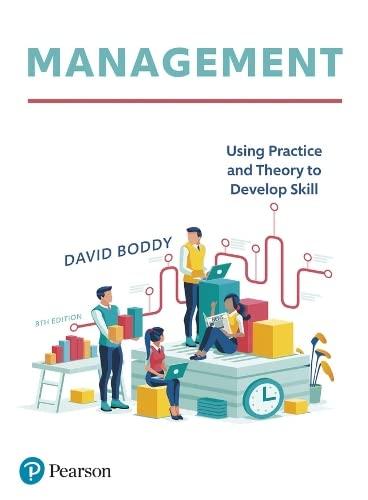Question
Chapter 9: Designing Adaptive Organizations What Would You Do? Case Assignment- Group Eli LillyIndianapolis, Indiana Tick-tock. After being named Lillys new CEO, you sent each
Chapter 9: Designing Adaptive Organizations
What Would You Do? Case Assignment- Group Eli LillyIndianapolis, Indiana
Tick-tock. After being named Lillys new CEO, you sent each top executive a digital clock counting down the time to October 23, 2011, the day that Lillys 20-year patent runs out on Zyprexa, a schizophrenia drug which generates $5 billion a year in revenue. On that day, Eli Lilly loses the exclusive right to sell Zyprexa, and other drug manufacturers will begin selling generic versions for much lower prices. Lilly has seven other major drugs that will fall off the patent cliff in the next seven years, and stands to lose 75 percent of its annual revenue if it doesnt generate new blockbuster drugs. Like a Hollywood studio, Lilly needs to keep coming up with blockbusters in order to sustain profitability and market share. Hence, the message inscribed on the clocks, Do what we do, that is, discover and develop new drugs at Lilly. Tick-tock.
Lilly isnt the only pharmaceutical company in this situation. Over the next three years, the entire industry will see half of its revenues fall off patent as three dozen major drugs become eligible to be sold as generics. When that happens, the company that held the patent typically sees sales of that drug drop by 80 percent. Pfizer will lose an estimated $13 billion a year when Lipitor, the top-selling statin, a cholesterol-lowering drug, loses its patent. By 2012, Merck will lose patent protection on its three top-selling drugs, Fosamax (osteoporosis), Singulair (asthma), and Cozaar (blood pressure), which account for 44 percent of its sales.
Unfortunately, Lilly has been here before, when its patent expired on Prozac, a drug for depression, taken daily by 40 million people. Then-CEO Sidney Taurel said, The situation we had in the mid-1990s, of having 35 percent of our sales dependent on Prozac, won't repeat itself. Taurel took steps to energize Lillys drug development by increasing the research and development (R&D) budget by 30 percent, hiring 700 new scientists, and instructing Lillys 7,000 researchers to focus on drugs that could produce 500 million dollars a year in sales. This time, however, expanding headcount and increasing R&D budgets arent options. With the potential loss of so much revenue, you had to lower costs. Accordingly, you laid off 5,500 workers and cut $1 billion in annual expenses. Les Funtleyder, an analyst at Miller Tabak & Co. in New York, said, Its been another tough year for Big Pharma [cutting 37,000 jobs]. Lilly is not in this boat alone, by any means. But they probably have the biggest immediate challenge, because their patent cliff is so steep.
With those short-term steps behind you, the long-term challenge is to grow Lillys drug pipeline? But how? You need to encourage faster, less expensive innovation, which is never easy. Some think that large budgets, centralized approval for allocating research dollars, and siloed research (where few know and understand what others in the company are working on) stifle innovation and slow the decision-making process. If thats the case, what might Lilly do internally to restructure itself to improve communication in product development teams and speed up the entire drug development process? Also, if the traditional company structure used by pharmaceutical firms, typically functional, product, or matrix structures, havent been successful at encouraging drug development, are there nontraditional organizational structures that Lilly could use to do so that can also help to speed development and lower costs? Finally, to what extent should Lilly outsource parts of its drug development process to outside vendors and companies? Because you risk creating new competitors with your own dollars when you outsource, a general guideline is to only outsource noncore business activities. But when youre a pharmaceutical firm, drug development is the core of your business. Is there a way for Lilly to effectively outsource drug development that gets around those risks? Tick-tock. Tick-tock. The clock is running.
If you were Lillys CEO, what would you do?
Step by Step Solution
There are 3 Steps involved in it
Step: 1

Get Instant Access to Expert-Tailored Solutions
See step-by-step solutions with expert insights and AI powered tools for academic success
Step: 2

Step: 3

Ace Your Homework with AI
Get the answers you need in no time with our AI-driven, step-by-step assistance
Get Started


